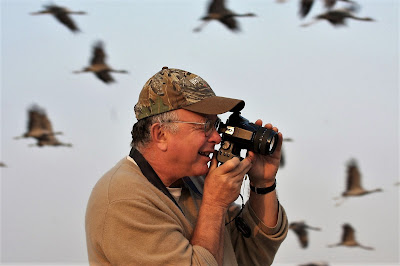 |
| Born in Nova Scotia, Dr. George Archibald co-founded the International Crane Foundation, a nonprofit devoted to protecting and preserving the world's 15 crane species. (Photo by K.S. Gopi Sundar) |
Meet the king of cranes
(published 7-18-17)
I’m far too young to have a “senior moment,” and if I’ve
ever had one I don’t remember it. But I experience Jurassic moments for sure. They
happen to me every year, in fact, usually in early spring and late fall.
I’m referring to the semi-annual sandhill crane migration.
Fossil records indicate the big, gray, magnificent birds have existed for at
least 10 million years. No living bird species is older. When the sandies soar,
swirl and bugle their way over my backyard—or the golf course, or the Jewel
parking lot—I am transported to Jurassic Park, DuPage County style.
Sandhills didn’t roam with dinosaurs but it’s easy to
imagine they did. Thankfully, it’s easy to observe them, too, which was not always
the case. The sandhill crane was in steep decline prior to the Migratory Bird
Treaty Act and other protective measures last century. The birds helped
themselves, too, adapting to a newly agrarian landscape along their migration
path. Fields of corn stubble now fuel their long journeys.
With an estimated population of 600,000, the sandhill is
conservation success story. But there are 14 other species of crane in the
world, 11 of which are in a race against extinction. The rarest of them all is
the whooping crane, with less than 500 in the wild.
Enter the International Crane Foundation in Baraboo, Wis., a
crane’s best friend. Established in 1973 by George Archibald and Ron Sauey, a
pair of Ph.D.’s who met at Cornell University, the ICF is a world center for
crane research and preservation. The work of its staff, volunteers and partners
around the globe is inspiring, innovative and vital to the species it serves.
I’m an ICF supporter and follow the organization’s progress,
particularly its activities involving whooping cranes. This column, in 2016,
highlighted the foundation’s newly launched “I Give a Whoop!” campaign.
 |
Until recently, though, I was mostly ignorant of ICF’s
remarkable achievements outside of North America. My enlightenment arrived in
the form of “My Life with Cranes,” Archibald’s memoir published last year. To
my surprise, a personally endorsed copy arrived in my mailbox in May, a kind
gesture heralding of the author’s scheduled appearance at Cantigny Park later
this month.
The book’s stories, some deeply personal, depict a man on an
extraordinary mission. His official ICF bio says it best: "Archibald is a
conservation ambassador who uses his unique brand of crane diplomacy to work in
sensitive places. He leverages the charisma of cranes to unite people of
diverse cultures and countries to work together to preserve the landscapes
necessary for the survival of both cranes and people."
Archibald is the Jane Goodall of cranes, and the world’s
foremost “craniac.” At age 71 he still travels extensively, focusing on
programs in Bhutan, China, India, Mongolia, North Korea, South Africa, South
Korea, Russia and the United States.
North Korea, really?
Yes, because birds have no geographic or political boundaries. Wherever
cranes live, ICF is on the ground protecting them, directly and through alliances
and partnerships. It is an international organization in the purest sense, supporting
conservation programs in 45 countries.
Archibald’s book could rightfully be subtitled “The
Adventures of Curious George.” One of my favorite stories occurs in Beijing in
the 1970s. At 3 a.m., unable to sleep, Archibald leaves his hotel room to go
for a jog. From the direction of the city’s zoo he hears the bugle of a
black-necked crane, the one crane species he has not yet witnessed, in the wild
or otherwise. Finding the call irresistible, Archibald manages to slip into the
closed zoo and locate the source. And unlike the fictional George, he doesn’t
get caught!
“My Life with Cranes” mostly covers 40 years of serious field
research and conservation work, often carried out in difficult and dangerous
conditions. Along the way, Archibald applies his passion for cranes,
extraordinary people skills and the science of captive breeding techniques to
help secure the future of his favorite birds. He makes some lifelong friends
and blows out a few passports, too.
Oh, and because of the book, I now understand why the
International Crane Foundation (savingcranes.org) is based in sleepy little Baraboo.
The center welcomes visitors and houses all 15 of the world’s crane species.
It’s a day trip well worth taking. Better yet, stay overnight and go birding at
Horicon Marsh (64 miles east) the next day.
Archibald’s presentation on July 25 is co-sponsored by
Cantigny and the DuPage Birding Club. The program and parking are free. If you
like birds—and cranes in particular—don’t miss this rare opportunity to hear
from a legendary conservationist.
Copyright 2017 by Jeff Reiter. All rights reserved.